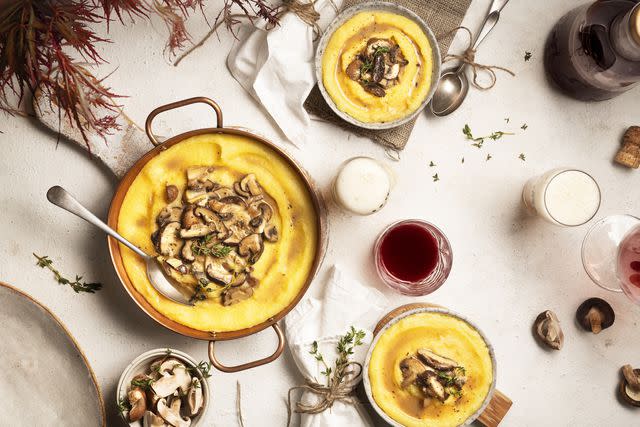What Is Polenta?
This Italian staple might look like a close cousin to a beloved Southern staple, but it has its own set of rules.
If you've ever looked at a package of polenta, you might have wondered, isn't this just cornmeal? Although popular across Italy, polenta isn't nearly as ubiquitous in the U.S. You'll most often encounter it on restaurant menus in America, where its either served ultra creamy with a porridge-like consistency, or is fried as a polenta cake.
Don't worry, we'll clear up what this Italian staple is, how you cook it, and how best to serve it. Lucky for Southerners, cooking polenta is fairly similar to preparing grits, making it that much easier to incorporate into your cooking repertoire.

Getty Images
What Is Polenta?
Polenta refers to both the raw Italian cornmeal product and the cooked dish.
Let's start with the cornmeal: There are multiple types of polenta, as it can be made from both yellow and white corn, but yellow polenta is the most common type.
Polenta can also vary in texture, ranging from a fine or medium grind to coarse, but coarse yellow cornmeal is what you'll most commonly find labeled polenta.
Polenta as a dish can be prepared multiple ways. Primarily. it's cooked and served as a hot porridge that serves as the strachy base of a dish. Traditionally it's prepared in a large copper pot, and stirred with a long wooden paddle. (A regular pot and wooden spoon work just as well.)
If allowed to cool, polenta thickens and firms up. If you've ever seen "tubes" of polenta sold at the grocery store, that's precooked and cooled polenta. Once firm, polenta can be sliced and pan-fried, giving it a crispy exterior while maintaining a creamy interior. These are often called polenta cakes.
What Does Polenta Taste Like?
On its own, polenta has a mild corn flavor. It's fairly neutral tasting and takes on the flavors of the ingredients added to it, like butter and cheese.
How Polenta Is Served
Polenta is often used as an alternative to serving pasta or another starch with a dish, and is frequently enjoyed in Italy simply with a ragu on top, like pasta. You'll often find polenta under any stewed, braised, or roasted meat, like short ribs, as it's used to absorb the sauce of a dish, not unlike mashed potatoes under pot roast. It can also be eaten alone with just butter and Parmesan folded in.
Polenta Preference
In Northern Italy, polenta is more popular than pasta. So much so, Northern Italians have earned the nickname, polentoni or polenta-eaters.
Polenta vs. Grits
We've covered the differences between polenta and grits before, but it comes down to the type of corn each uses—grits are usually white corn, and polenta is usually yellow—and the coarseness of the grind.
That said, both corn products come in all sorts of colors and grinds, so the difference also lies in how each is cooked and enjoyed.
If you want to get real picky, true Italian polenta uses flint corn, an heirloom variety that holds its texture better than what most grits are made, which is dent corn.
How To Make Polenta
This is a basic guide to cooking polenta. For a creamy polenta, use four parts water to one part polenta (i.e. four cups water for every cup of polenta). At its simplest polenta is made with just water (and salt), but it can also be made with stock or milk for a richer flavor.
Start by bringing salted water to a boil.
Gradually add the polenta, while stirring the entire time with a whisk.
Reduce the heat to medium-low and switch to a wooden spoon. Cook until thickened and the polenta cleanly pulls away from the sides of the pot, stirring the mixture often and making sure to scrape down the sides and bottom of the pan.
Finish with butter and grated cheese (like Parmesan), to taste. Serve immediately.
To serve firm: Transfer polenta to an oiled sheet pan, spread into an even layer, and cool to room temperature. Cover it with plastic wrap and transfer it to the fridge to firm up before slicing and pan-frying.
Frequently Asked Questions
Is polenta just cornmeal?
Well, yes. The term polenta on a package simply indicates that the cornmeal is suitable for preparing the dish (the right grind, for example). That said, you don't need to use bags labeled polenta; you can use regular or coarsely-ground cornmeal instead.
Is polenta gluten-free?
On its own, yes. When cooked, it's most likely gluten-free, unless the chef or person preparing it has added an ingredient with gluten to it.
What about instant polenta?
Much like instant grits, you can buy instant polenta, but just like most Southerners, most Italians swear off the instant stuff as the final product can be quite gummy.
For more Southern Living news, make sure to sign up for our newsletter!
Read the original article on Southern Living.

